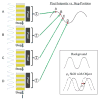X-ray phase sensitive imaging methods: basic physical principles and potential medical applications
- PMID: 23970846
- PMCID: PMC3747977
- DOI: 10.2174/157340510791268533
X-ray phase sensitive imaging methods: basic physical principles and potential medical applications
Abstract
Phase sensitive imaging theoretically allows for a drastic reduction in x-ray dose while simultaneously achieving comparable or better spatial and contrast resolution compared to traditional x-ray absorption based imaging. Several techniques exist to extract the phase information from an x-ray signal, including x-ray interferometry, diffraction enhanced imaging, in-line holography, coded aperture x-ray imaging, and grating-based interferometry. The physics of each method is reviewed, along with the potential clinical applications.
Keywords: CT; DEI; in-line holography; phase contrast; x-ray interferometry.
Figures











Similar articles
-
Spherical grating based x-ray Talbot interferometry.Med Phys. 2015 Nov;42(11):6514-9. doi: 10.1118/1.4933195. Med Phys. 2015. PMID: 26520741 Free PMC article.
-
Empirical beam hardening and ring artifact correction for x-ray grating interferometry (EBHC-GI).Med Phys. 2021 Mar;48(3):1327-1340. doi: 10.1002/mp.14672. Epub 2021 Jan 10. Med Phys. 2021. PMID: 33338261
-
Performance evaluation of x-ray differential phase contrast computed tomography (PCT) with respect to medical imaging.Med Phys. 2012 Aug;39(8):4761-74. doi: 10.1118/1.4736529. Med Phys. 2012. PMID: 22894401
-
Development of phase-contrast X-ray imaging techniques and potential medical applications.Phys Med. 2008 Sep;24(3):129-48. doi: 10.1016/j.ejmp.2008.05.006. Epub 2008 Jul 7. Phys Med. 2008. PMID: 18602852 Review.
-
Phase recovery and lensless imaging by iterative methods in optical, X-ray and electron diffraction.Philos Trans A Math Phys Eng Sci. 2002 May 15;360(1794):875-95. doi: 10.1098/rsta.2001.0972. Philos Trans A Math Phys Eng Sci. 2002. PMID: 12804284 Review.
Cited by
-
The meaning of interior tomography.Phys Med Biol. 2013 Aug 21;58(16):R161-86. doi: 10.1088/0031-9155/58/16/R161. Epub 2013 Aug 2. Phys Med Biol. 2013. PMID: 23912256 Free PMC article. Review.
-
3D quantification of nanolites using X-ray ptychography reveals syn-eruptive nanocrystallisation impacts magma rheology.Nat Commun. 2025 Aug 1;16(1):7083. doi: 10.1038/s41467-025-62444-z. Nat Commun. 2025. PMID: 40750794 Free PMC article.
-
Four-Fold Multi-Modal X-ray Microscopy Measurements of a Cu(In,Ga)Se2 Solar Cell.Materials (Basel). 2021 Jan 5;14(1):228. doi: 10.3390/ma14010228. Materials (Basel). 2021. PMID: 33466442 Free PMC article.
-
Nanoscale cuticle mass density variations influenced by pigmentation in butterfly wing scales.Nat Commun. 2025 Aug 1;16(1):7085. doi: 10.1038/s41467-025-62010-7. Nat Commun. 2025. PMID: 40750578 Free PMC article.
-
Interior tomography in x-ray differential phase contrast CT imaging.Phys Med Biol. 2012 May 7;57(9):N117-30. doi: 10.1088/0031-9155/57/9/N117. Epub 2012 Apr 11. Phys Med Biol. 2012. PMID: 22491072 Free PMC article.
References
-
- Wu X, Dean A, Liu H. X-ray diagnostic techniques. Chapter 26. CRC Press; Tampa, Florida: 2003. Biomedical photonics handbook; pp. 26–21.pp. 26–34.
-
- Fitzgerald R. Phase-sensitive x-ray imaging. Physics Today. 2000;53:23–26.
-
- Alvarez RE, Macovski A. Energy-selective reconstructions in x-ray computerised tomography. Physics in medicine and biology. 1976;21:733–744. - PubMed
-
- Born M, Wolf E. Principles of Optics. Pergamon Press; New York: 1993.
-
- Als-Nielsen J, McMorrow D. Elements of Modern X-ray Physics. John Wiley & Sons Ltd; New York: 2004.
Grants and funding
LinkOut - more resources
Full Text Sources
Other Literature Sources
